Do you love vintage spaces but want a modern kitchen? You’re not alone.
More people are bringing back the charm of 1970s kitchens, bold colors, wood cabinets, and funky patterns, while keeping things fresh and updated.
It’s easier than you think to capture that retro feel without making your kitchen look outdated. The key is knowing which 70s elements to use and how to modernize them.
In this guide, I’ll walk you through the key design features from the 70s and show you how to mix them with modern touches.
If you’re after a cozy, retro vibe or a functional kitchen with a twist, this guide will help you create the perfect space.
What Made 70s Kitchens Unique?

The 1970s were all about bold choices, warm colors, and comfort in the kitchen. These spaces became the heart of the home, with cozy breakfast nooks, patterned floors, and plenty of wood tones.
People loved mixing bright colors like orange, green, and yellow with dark cabinets or shiny surfaces.
Open shelving, hanging pot racks, and wall-mounted phones were common, reflecting the era’s relaxed and self-expressive vibe.
Kitchens in the 70s weren’t just functional, they were a place for fun and togetherness.
To recreate that unique vibe today, it’s helpful to understand what made these kitchens so special and memorable so that you can bring them back with your own modern twist.
Cultural Influence of 70s Kitchen Design

The 1970s kitchen reflected the era’s values and culture, focusing on warmth, natural elements, and open spaces. Here’s a breakdown of what defined these kitchens:
- Earthy Tones: Green, brown, and orange dominated, reflecting a desire for natural and peaceful surroundings.
- Natural Materials: Wood, plants, and natural light were key, showing an increased care for the environment.
- Open Layouts: Kitchens became larger and more open for family gathering, eating, and cooking in one space.
- Cultural Influence: Bold pop culture trends, like vibrant colors in fashion and movies, influenced kitchen styles.
- Personal Expression: Patterns, bright-colored appliances, and funky wallpapers added personality to the space.
These elements made 70s kitchens feel warm, lively, and inviting, perfect for family connection.
Common Layouts and Shapes
The 1970s kitchen was all about functionality and warmth, featuring layouts that encouraged family interaction and efficiency.
- Galley kitchens: A long, narrow layout with two parallel counters. Great for small spaces.
- U-shaped kitchens: Cabinets and counters on three sides. Easy to cook with everything in reach.
- Breakfast nooks: Small, cozy eating areas, often with built-in benches or a round table.
- Kitchen islands: Extra work space in the middle of the room, perfect for prep or casual meals.
- Open shelving: Dishes, mugs, and plants were on display instead of hidden in cabinets.
- Hanging pot racks: Pans and pots hung from the ceiling, adding storage and a retro look.
These practical and stylish designs created kitchens that were not just spaces for cooking but hubs for family connection.
Key Features of Iconic 70s Kitchen Design
70s kitchens were full of warmth, bold colors, and comfort. They mixed fun patterns with natural textures, creating a space that felt cozy and lived-in. Below are the key features that defined the look.
1. Avocado Green Appliances
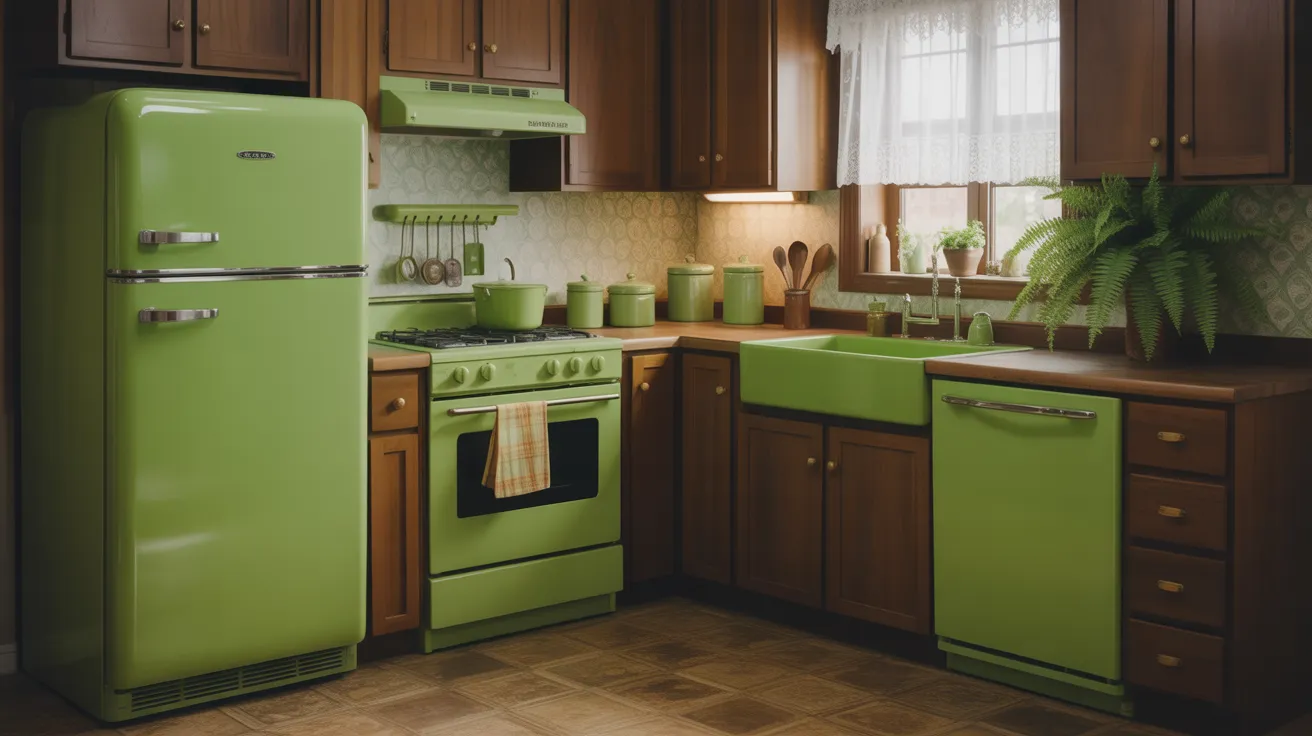
In the 1970s, avocado green was everywhere. It was one of the most popular colors for kitchen appliances like fridges, ovens, and dishwashers.
The color gave kitchens a cozy, earthy look that felt warm and inviting. People liked it because it was different from the plain white or silver appliances used today.
Avocado green worked well with wood cabinets and brown floors, making the whole space feel natural.
If you want to add 70s style to your kitchen, try using this shade on small appliances or even a painted cabinet.
2. Mustard Yellow Accents
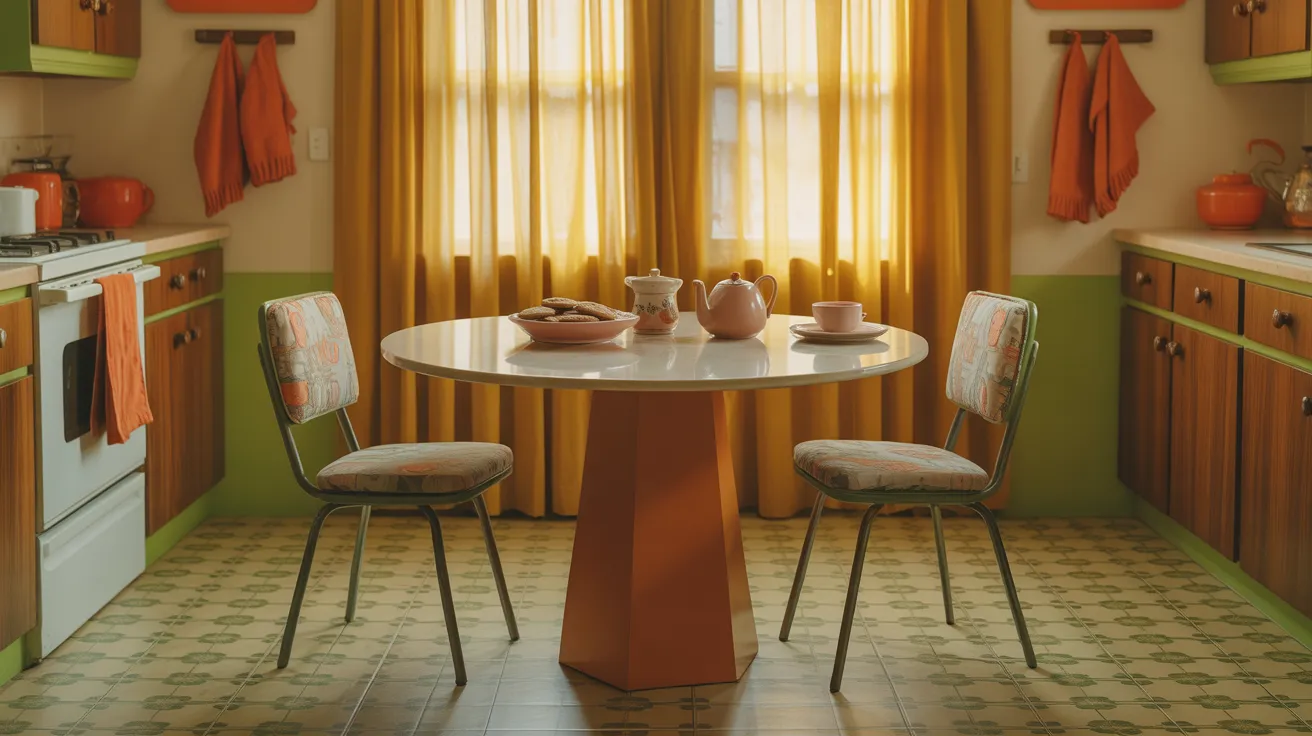
Mustard yellow was another big color in the 70s. It showed up on walls, curtains, dish towels, and even kitchen chairs.
The color added a sunny, happy feeling to the room. It worked well with wood tones, avocado green, and orange.
People used it to brighten up dark cabinets and patterned floors. If you want to bring this color into your kitchen today, try adding mustard yellow dishes, rugs, or wall art.
A little bit goes a long way, and it gives your space that warm, retro look without being too bold.
3. Wood Veneer Cabinets
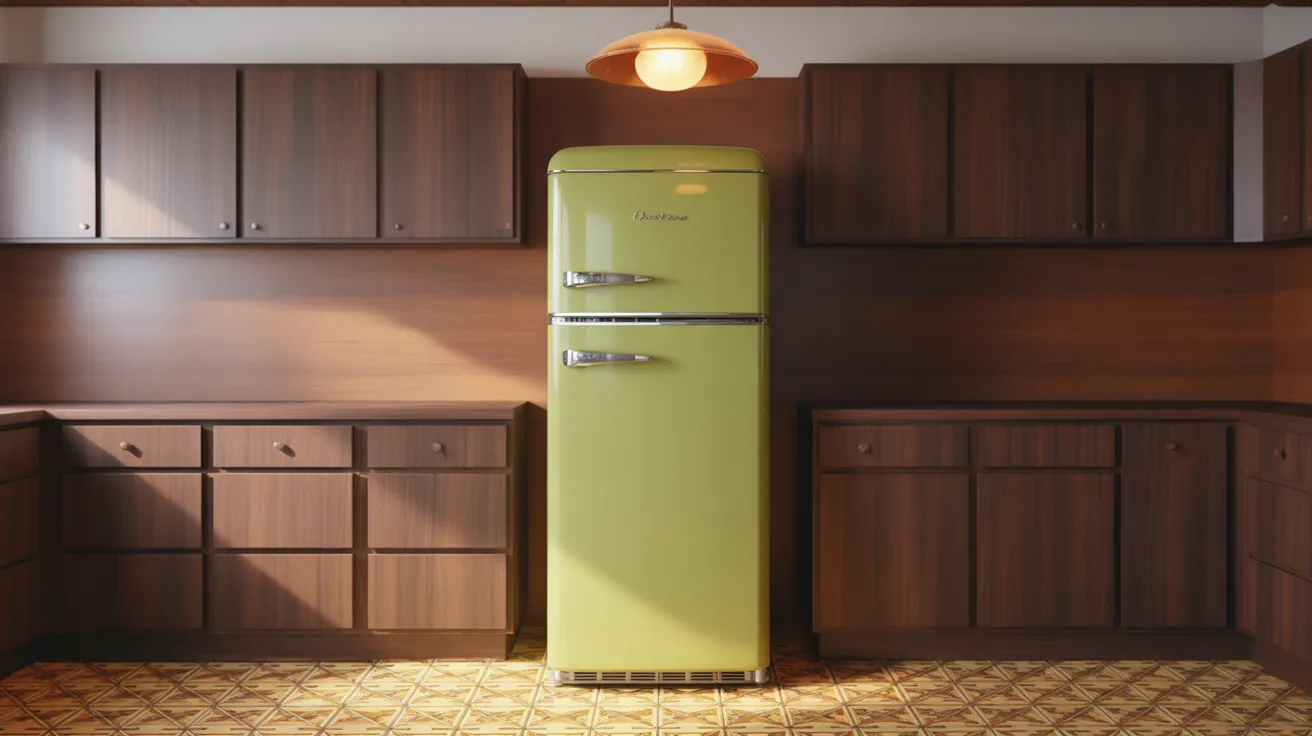
Most 70s kitchens had cabinets made with wood veneer. This means a thin layer of wood was glued onto the front of the cabinet to give it a solid wood look without the cost.
These cabinets were usually dark brown or golden in color. They added a natural, cozy feel to the kitchen.
The grain of the wood often stood out, giving the space a lot of texture.
If you like this look, you can use peel-and-stick wood veneer today or choose stained wood cabinets that bring back that same warm feel.
4. Laminate Countertops

Laminate was a popular countertop material in the 70s because it was cheap and easy to clean.
It came in lots of colors and patterns-everything from bright orange to fake marble. People loved that it was smooth, shiny, and added color to the kitchen.
Even though laminate isn’t used as much today, it’s still a great choice for getting that 70s style. Modern laminate is even stronger and better-looking.
You can try fun patterns or soft retro colors like yellow, green, or tan for a throwback look that still feels fresh.
5. Vinyl or Linoleum Floors
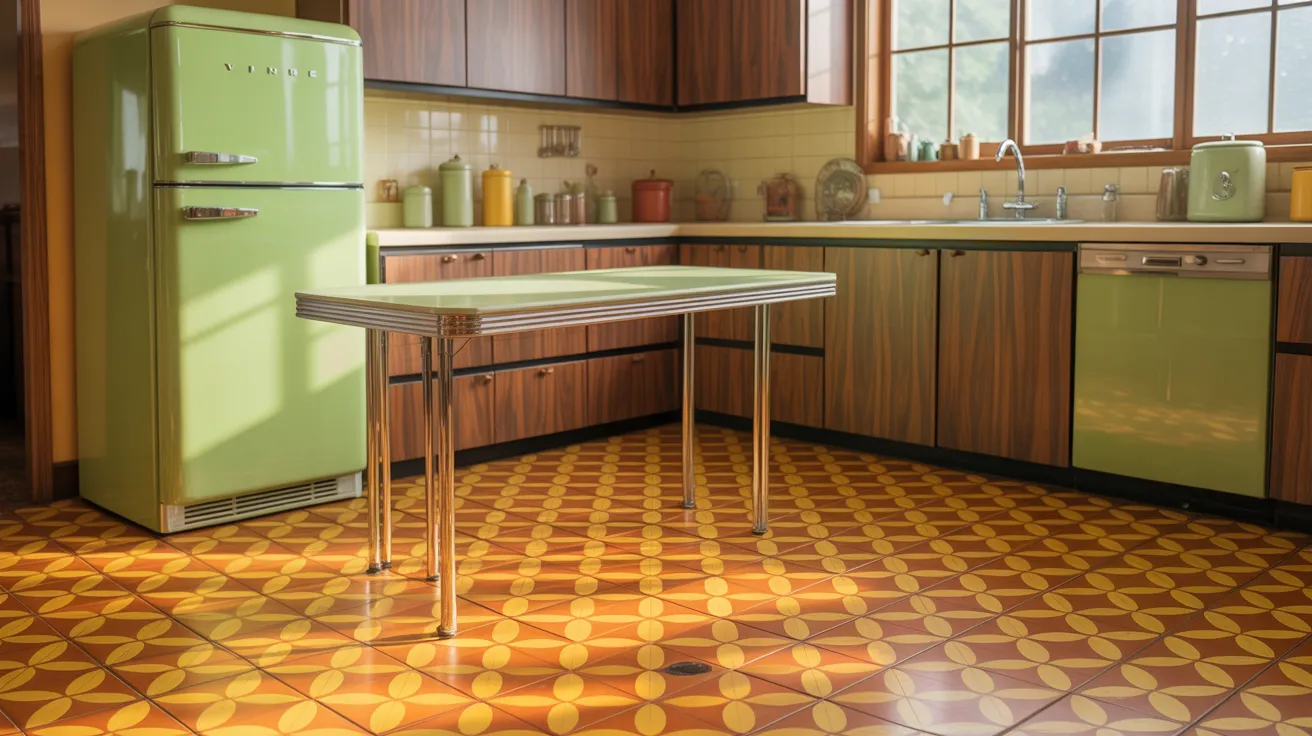
Back in the 70s, vinyl and linoleum were go-to choices for kitchen flooring. They were soft under your feet, easy to clean, and didn’t cost much.
These floors often had bold patterns-think swirls, flowers, or colorful squares. Some even looked like tile or brick.
People liked how the floor added personality to the space. Today, vinyl is still popular and much better made.
You can find modern versions with cool retro patterns if you want to copy that ’70s vibe.
It’s an easy way to bring style and comfort into your kitchen.
6. Geometric and Floral Wallpaper

Wallpaper in the 70s was bold, bright, and full of life. Kitchens had walls covered in big flowers, zigzags, and shapes like circles or diamonds.
These prints made the space fun and playful. People often used wallpaper on just one wall to make it stand out.
If you want that look today, peel-and-stick wallpaper is a great choice. It’s easy to apply and remove.
Choose a pattern with warm colors like orange, green, or brown for that true 70s feeling. It adds instant style without a big remodel.
7. Hanging Pot Racks

Hanging pot racks were very popular in 70s kitchens. Instead of hiding pots and pans in cabinets, people liked to hang them where they could see them.
This made cooking easier because everything was within reach. Plus, it added a cozy, lived-in look to the kitchen.
Racks were usually made of wood or metal and hung from the ceiling. Today, this idea still works, especially in small spaces.
If you hang your cookware, it frees up cabinet space and gives your kitchen a classic, retro feel with a touch of warmth.
8. Orange and Brown Color Combos
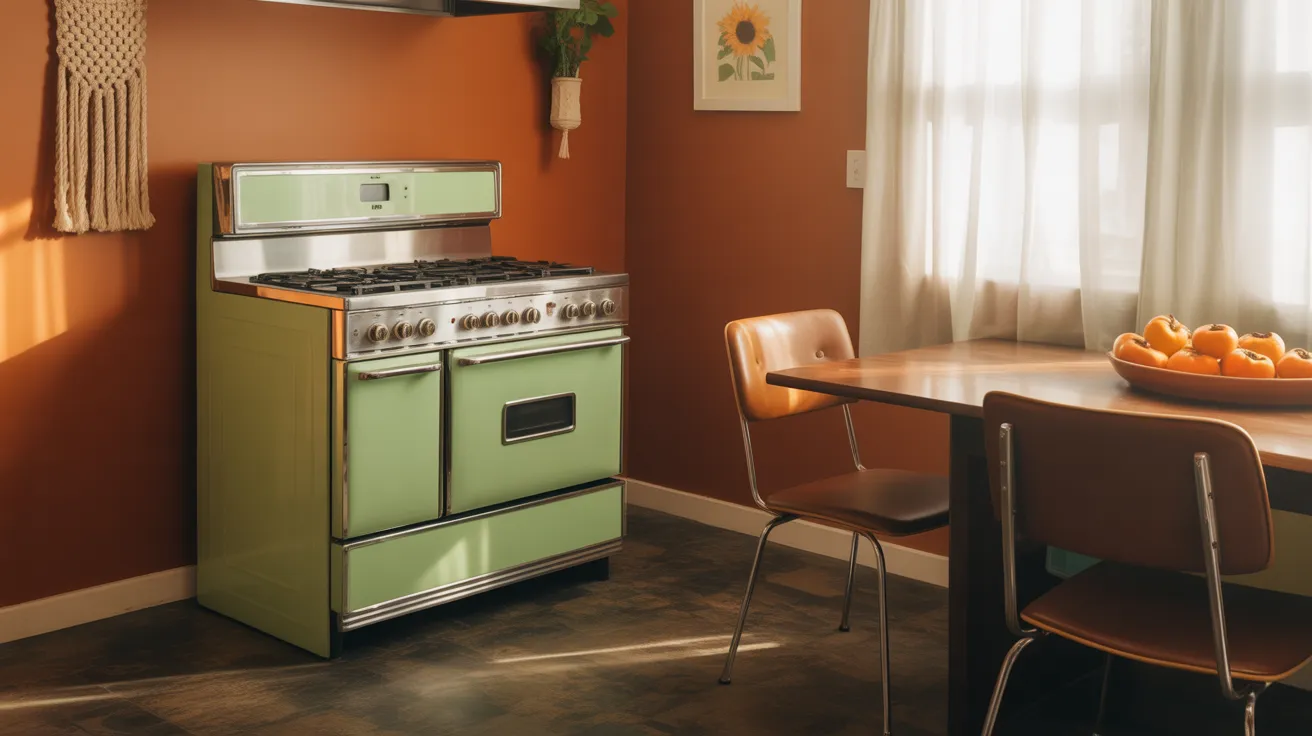
Orange and brown were a favorite pair in 70s kitchens. You’d see burnt orange walls with dark brown cabinets or brown tile floors with orange counters.
This mix felt warm, cozy, and full of energy. It worked especially well with wood and natural light. If you want to try this color combo today, you don’t need to go overboard.
Even a few touches, like orange dishes or brown chairs, can give your kitchen that vintage look.
It’s an easy way to add some bold 70s style while keeping things simple and modern.
9. Chunky Hardware
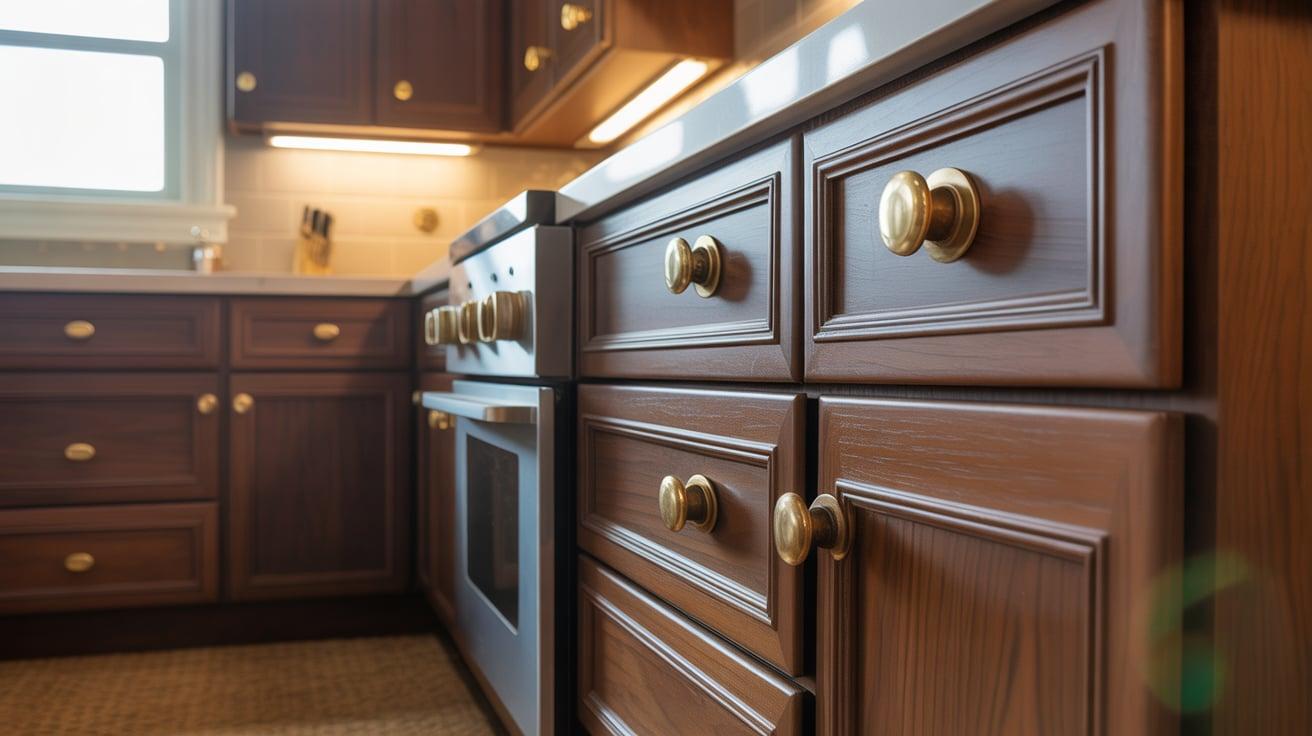
In the 70s, kitchen cabinets and drawers often had big, chunky handles. These pulls and knobs were usually made of brass, wood, or plastic.
They were bold and easy to grab, which made them both stylish and useful. The size and shape of the hardware gave the cabinets extra character.
If you want to bring this feature into your home today, look for vintage-style knobs or wide drawer pulls.
Even a small change like this can make a big difference and bring some retro style into your kitchen.
10. Checkerboard or Mosaic Tile Backsplashes
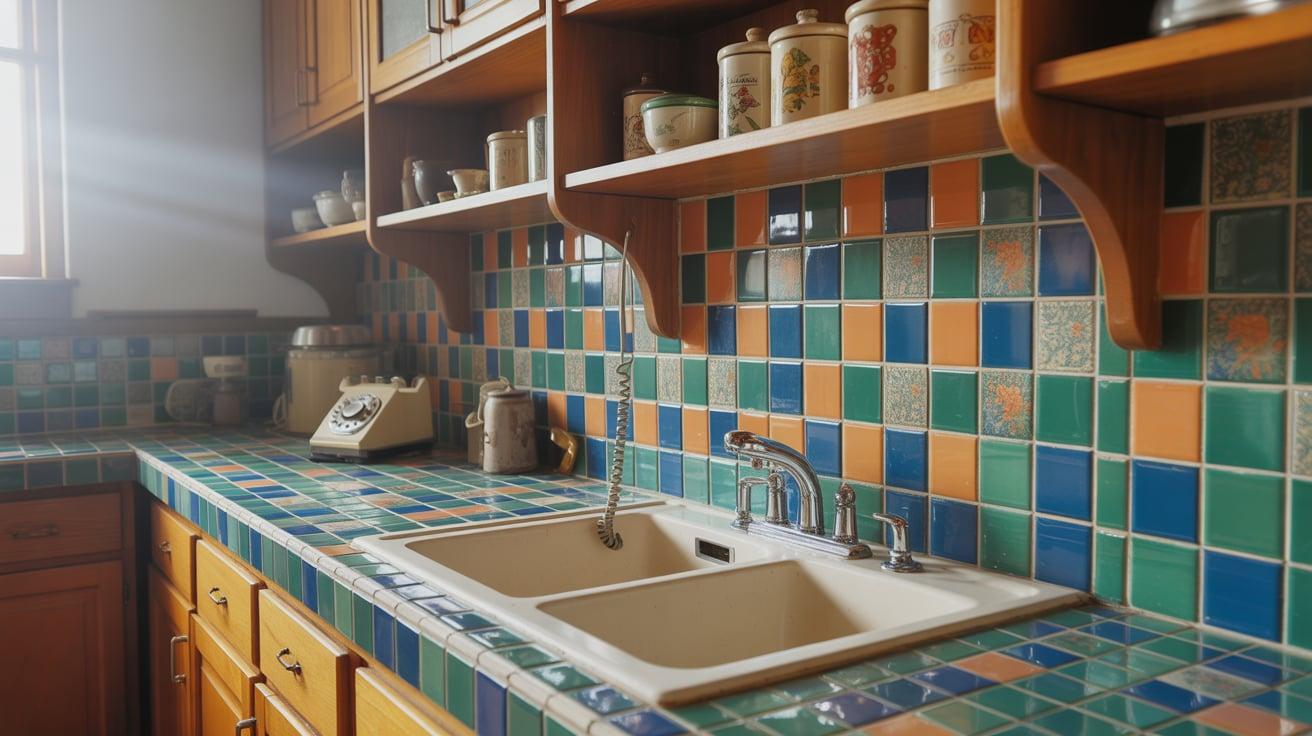
Backsplashes in 70s kitchens were anything but boring. People used checkerboard patterns or small mosaic tiles in fun colors like blue, orange, or green.
These tiles made the wall behind the stove or sink pop with personality. Some tiles even had little pictures or patterns on them.
To get this look now, try tile stickers or real tile in a fun pattern. It doesn’t have to cover the whole wall- just a section can make a big impact.
This simple touch brings texture, color, and vintage style to your space.
11. Wicker and Rattan Touches
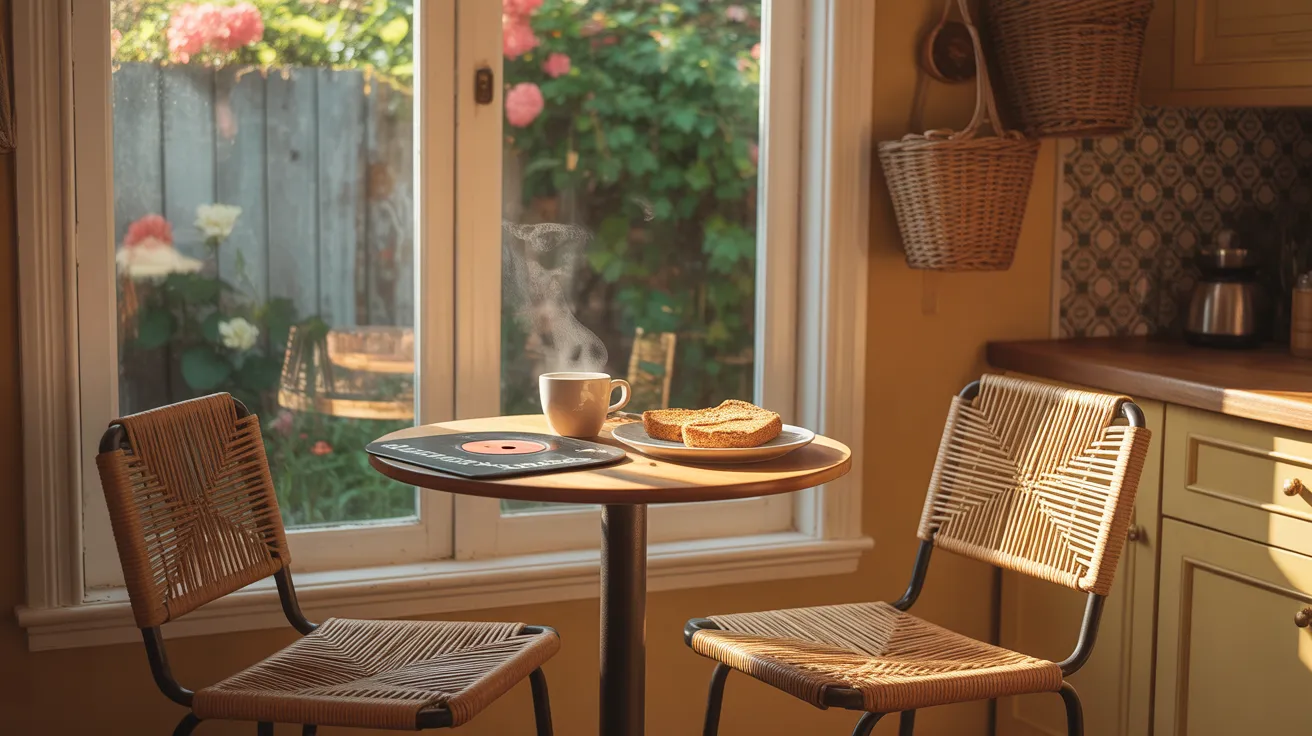
Wicker and rattan furniture became trendy in the 70s and even made their way into the kitchen. You’d often find bar stools, baskets, or light shades made from these materials.
They added a relaxed, natural look and worked well with all the earthy colors in the kitchen. Today, you can still find rattan stools, chairs, and light fixtures.
These items bring warmth and texture to your space. If you want a 70s touch without going overboard, a few wicker pieces will do the trick and still feel stylish.
12. Funky Lighting Fixtures
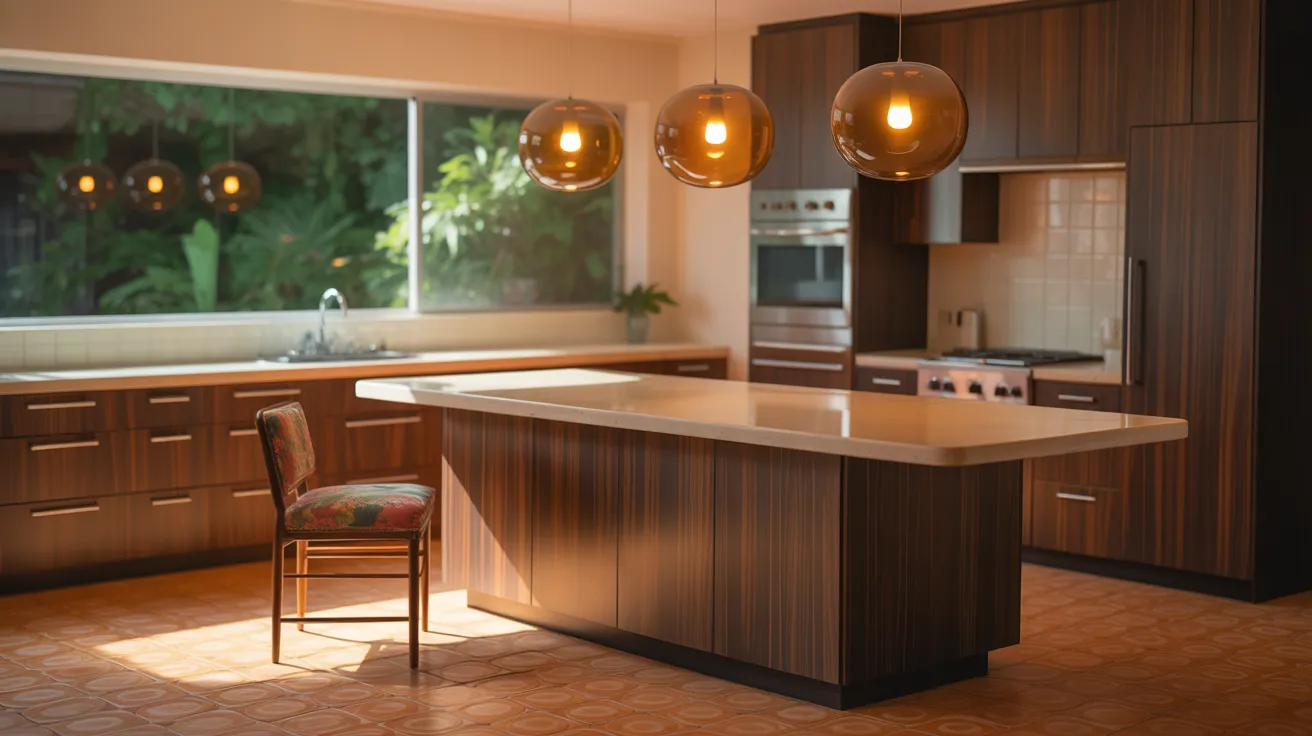
Lighting in 70s kitchens wasn’t plain. People used funky pendant lights, globe lights, and hanging lamps with tinted glass, often in amber, orange, or green.
These lights gave the kitchen a cool glow and acted like art pieces. The shapes were round, bubbly, or even flower-like.
If you want to copy this style today, look for lights with fun shapes or retro glass colors.
A unique fixture above your table or island can give your kitchen personality and help capture that fun, vintage mood of the 70s.
13. Open Shelving
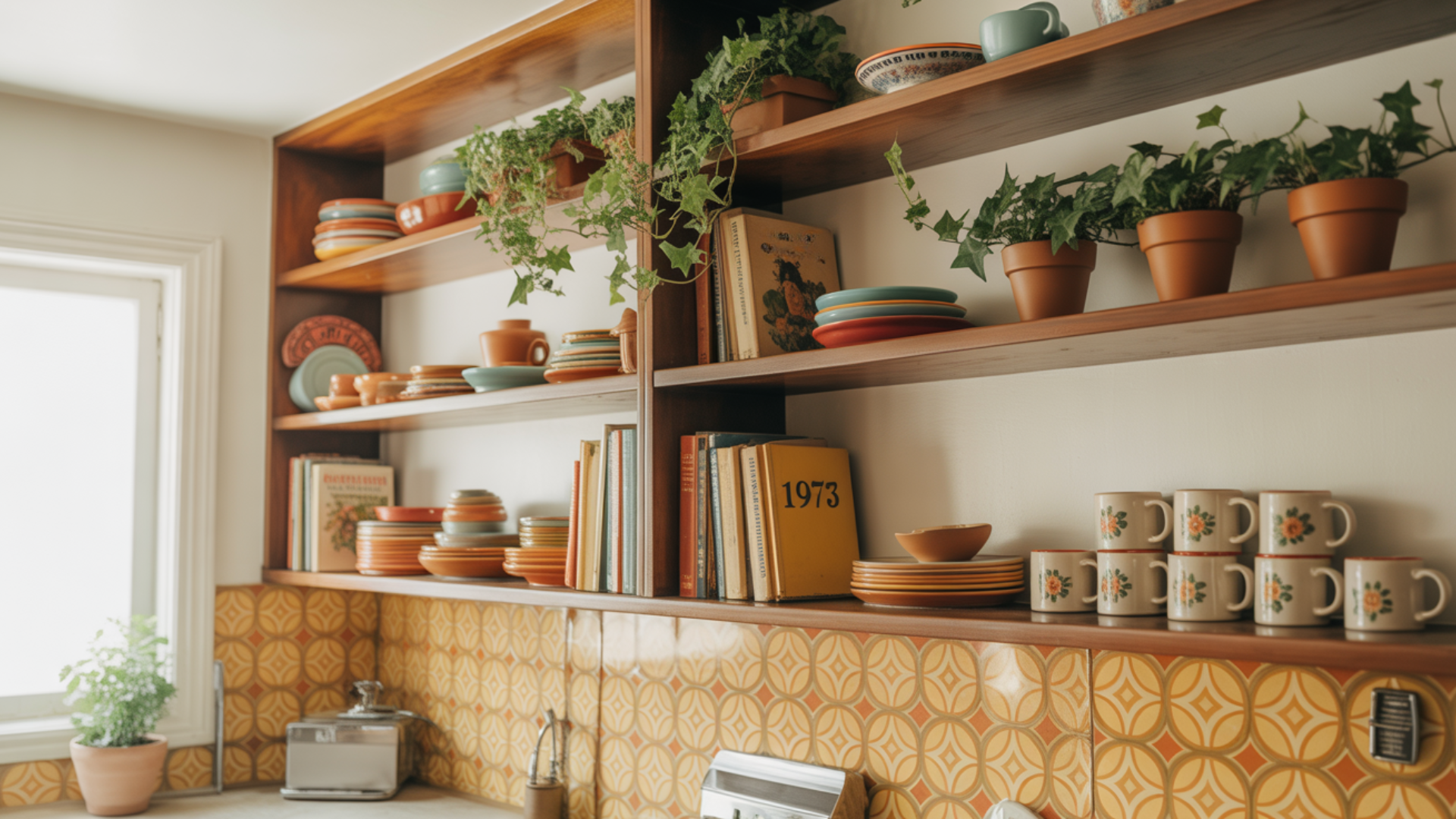
Many 70s kitchens used open shelving instead of upper cabinets. This made the kitchen feel more open and gave people a place to show off their dishes, cookbooks, and plants.
It also made it easier to grab things while cooking. Shelves were often made of wood and matched the rest of the cabinets.
If you want to try this today, add a few wooden shelves to a blank wall. Keep your items neat and mix in some decor pieces for that relaxed, retro look that’s still very useful.
14. Built-In Breakfast Nooks
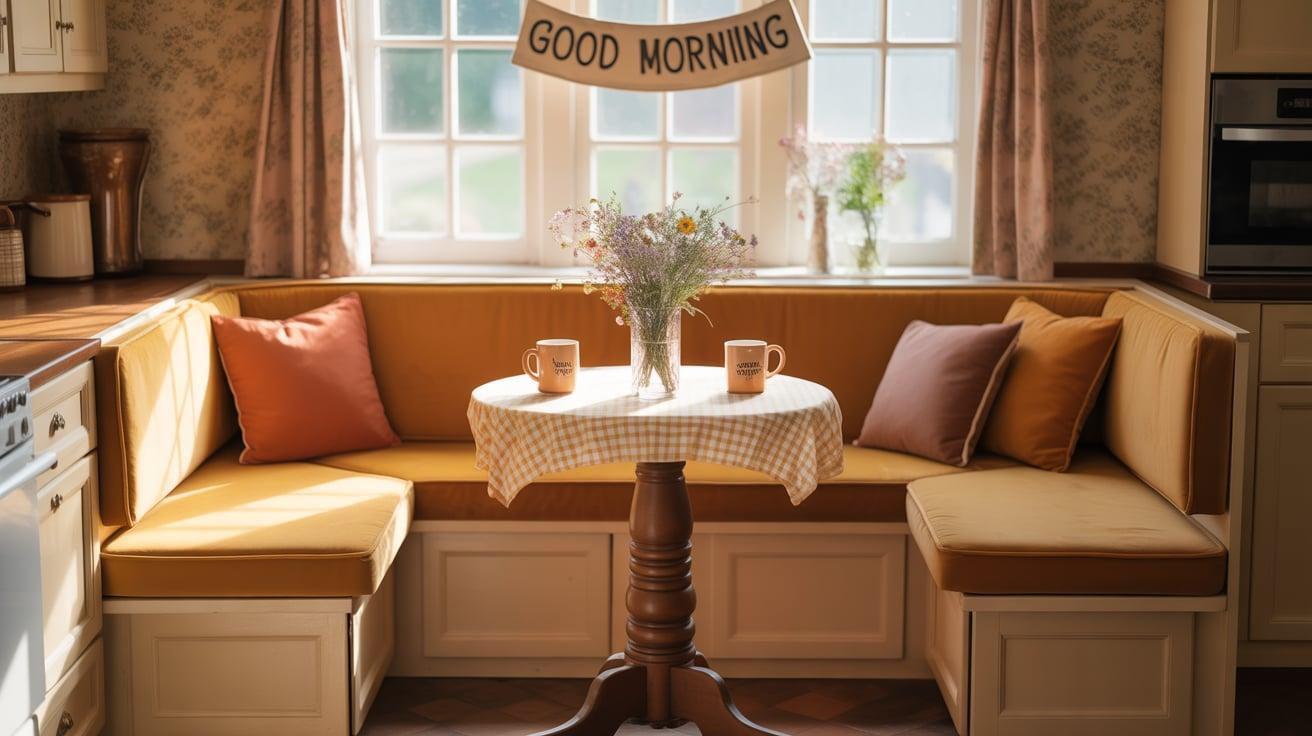
Breakfast nooks were cozy little spaces built into the kitchen, often with padded benches or corner seating.
Families used them for quick meals, homework, or just hanging out. These nooks made the kitchen feel more connected and homey.
The benches usually had storage underneath, which helped save space.
If you like this idea, you can create a simple version with a small table, a bench, and a few soft pillows.
It’s a great way to bring comfort and 70s style into your kitchen while giving the whole family a spot to gather.
15. Retro Clocks and Wall Phones

Before smartphones, kitchens often had colorful wall phones and big, bold clocks. These items added fun and style while also being useful.
Phones came in red, yellow, or green and had long curly cords. Clocks were large, often with numbers you could see from across the room.
Today, you don’t need to plug in an old phone, but you can still use these pieces as decor.
A retro wall clock or a vintage phone on a shelf adds a playful 70s touch that makes your space feel more personal.
Tips to Keep It Stylish
Adding 70s style to your kitchen can be fun, but it’s easy to go too far. If you use too many bold colors or patterns, your space might feel more like a time capsule than a working kitchen. The trick is to mix old and new so your design feels fresh.
- Balance bold colors with minimal accents: Use bright shades in small doses to keep things from feeling overwhelming.
- Don’t overuse patterns: Choose one area, like a backsplash or wallpapered wall, to stand out.
- Use modern lighting and hardware: These updates help balance vintage elements and make the space feel current.
- Keep functionality and storage top of mind: Make sure your kitchen works well for daily tasks, even with its retro style.
Conclusion
A 70s-style kitchen is about warmth, color, and comfort. I like how it brings a relaxed and welcoming feeling to a space where people spend time together.
You don’t need to change everything to get that retro feel. Just a few updates, like wood shelves, bold colors, or a vintage light, can make a big difference.
What matters most is that your kitchen feels good to use and fits your daily needs. Mixing older looks with simple, modern updates can help you get the right balance.
I think starting small is a great way to see what works. If you’ve been thinking about adding 70s style to your home, I hope this gave you helpful ideas.
With a few thoughtful choices, you can build a space that looks fun, feels comfortable, and fits the way you live now.

